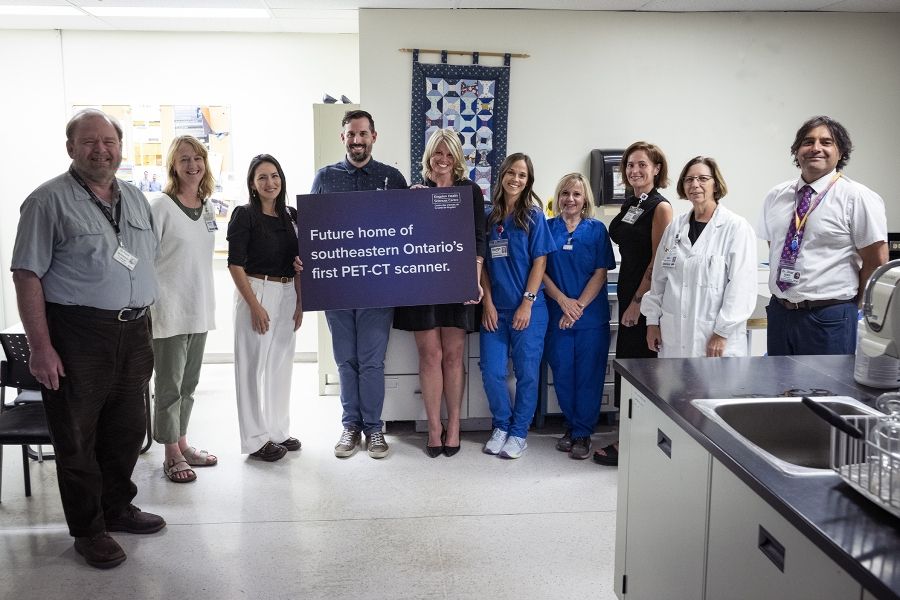Effective immediately masking is required for everyone when present on all inpatient units, in the Emergency Department (ED), the Urgent Care Centre (UCC), and the Children’s Outpatient Centre (COPC).
PET-CT Scanning
The new positron emission tomography-computerized tomography (PET-CT) scanner at KHSC will combine two types of imaging:
- Positron emission tomography (PET) uses a “tracer” compound to help reveal the metabolic or biochemical function of tissues and organs.
- Computerized tomography (CT) uses specialized x-ray equipment to produce multiple images of the inside of the body.
PET-CT is extremely sensitive and effective for non-invasive detection, diagnosis and for monitoring cancer treatment. It also has applications for cardiac and neurological diseases and will provide advanced imaging for both adults and pediatric patients.
The scanner will mean that patients no long need to travel out of the region to Toronto or Ottawa to receive advanced imaging care.
KHSC’s new scanner
In Sept. 2023, KHSC announced that it would be acquiring Southeastern Ontario’s first PET-CT scanner. This means that patients in the region will soon have improved access to state-of-the-art imaging technology.
Installing a new scanner is a complex and expensive process! Construction is already underway at the KGH site, and is expected to continue for the near future. The total cost for the scanner and associated construction will be approximately $10 million.
The scanner will be installed and hard at work scanning patients by early 2025!
If you’re at the KGH site, you may hear drilling or hammering noises as the foundation is being constructed for the new scanner.
This new device will meet a growing need in our region, and we anticipate we will be able to support approximately 1,000 patients in our first year. PET-CT is a rapidly expanding field. Partnering with GE HealthCare to bring this technology to KHSC, we are thrilled to provide a new service that will have a significant positive impact on patient care in our region. - Dr. Omar Islam, head of Radiology at KHSC
To support the arrival of PET-CT services, KHSC has also recruited a Molecular Imaging Radiologist and will soon be filling the lead PET-CT Technologist position to oversee the planning and implementation of this new service.
How it works
A “tracer” is a radioactive compound that is injected into a patient’s hand or arm. It’s then passed through the body and collects in areas that have high levels of metabolic or biochemical activity. Because many disease often cause atypical levels of activity, this can often pinpoint the location of a disease.
The test is also extremely sensitive, and can often find diseases before they appear in other imaging tests.
By combining the PET imaging with a CT scan, more detailed images can be obtained to help diagnose and monitor illnesses.
When it’s used
PET-CT scans can help identify a range of conditions, including cancer, heart disease and brain disorders.
- Cancer cells show up as bright spots on PET scans because they have a higher metabolic rate than do typical cells. PET-CT scans help detect cancer, determine if it has spread and see if treatment is working.
- PET scans can detect heart disease by revealing areas of decreased blood flow in the heart. This can inform the right course of action for treatment.
- PET scans can be used to check certain brain disorders, such as tumors, Alzheimer's disease and seizures.
The procedure
The PET-CT scanner is a large machine that looks a little like a giant upright ring, similar to CT or MRI scanners.
- The procedure typically takes about two hours to complete. Once the patient changes into their hospital gown and use the bathroom, the tracer is injected into a vein. After 30 to 60 minutes, the tracer is absorbed by your body.
- The patient then lies on a padded table that slides into part of the scanner. It takes between 15 to 20 minutes to complete a PET-CT scan.
- After the scan, a radiologist will examine the images and report the findings back to the ordering healthcare professional.

